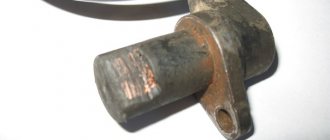The automatic transmission uses a lubricant that differs from the usual lubricant intended for manual transmissions. This fluid is called ATF.
Before adding oil to the transmission, you need to measure its volume and check what is written in the operating manual. To reliably determine the amount of lubricant in the gearbox, the check must be carried out when the engine is still warm.
If the trip lasted a long time (more than thirty minutes), then allow the engine to idle for at least a couple of minutes before taking measurements. During this time, the ATF temperature will drop to normal.
Experts advise riding five to seven kilometers for maximum accuracy of readings. Otherwise, there is a chance of error; you can underfill/overfill the oil fluid.
Automatic transmission oil
Official recommendations for changing automatic transmission oil: Toyota – once every 45 thousand km.
Skoda - once every 60 thousand km. Based on their experience, motorists advise changing the oil at intervals of 35 to 50 thousand km. In this case, manufacturers imply a so-called “refreshing” oil change - draining the old oil through the plug and pouring the same amount of fresh oil through the dipstick hole. It is recommended to make the same replacements once a year. If the car's mileage is more than 60 thousand km and the automatic transmission oil has not been changed, then this should not be done; the automatic transmission may fail. Making a partial or complete oil change in an automatic transmission is a personal matter for everyone. It all depends on the condition of the oil and the preferences of the car owner. It is recommended to check the condition of the oil (its level, color, transparency) every week. If the oil has darkened, acquired a “burnt” smell, or dark inclusions have appeared in it, change it. It is also advised to change the oil more often if the car is operated in difficult conditions, with a constant full load, or, for example, if it was towing another car, got stuck, etc.
On most cars, the oil level in the automatic transmission is checked in this way: start the engine, warm up the oil in the automatic transmission to operating temperature (for this you need to drive 15 - 20 km), then place the car on a flat horizontal platform, without turning off the engine, move the automatic transmission to position “P” " Remove the dipstick from the automatic transmission, wipe it dry, insert it back and remove it again. The dipstick should have marks indicating the required oil level for a cold (COLD) and hot (HOT) engine. The oil after the above manipulations should correspond to the HOT level. The COLD mark is needed to approximately determine the amount of oil filled in case of replacement.
On some cars (for example, a Honda Civic) there may be only one mark on the dipstick - COLD. The methods of checking the oil level on different brands of cars may also differ - for example, on a Honda, this is done after the oil has warmed up to operating temperature, but with the engine turned off. And on some other brands it is necessary to put the automatic transmission not in the “P” position, but in the “N” position (for example, on Mitsubishi automatic transmission models). Often, the position of the automatic transmission at which the oil needs to be checked is written on the dipstick along with the type of oil used in the automatic transmission.
If the oil level in the automatic transmission is lower than necessary, this may result in:
– the temperature of the oil will be disrupted; – its resource will sharply decrease; – the pump together with the oil can capture air and because of this, the oil will turn into an air-oil emulsion and become compressible, which will lead to a decrease in pressure in the system, which means the transmission will disappear, heat removal from the automatic transmission will be disrupted, and the lubrication of automatic transmission elements will deteriorate.
If the oil level in the automatic transmission is too high:
– the oil will begin to reach the rotating parts of the automatic transmission, which will foam it – this will have the same consequences as in the case of a low oil level; – foaming of the oil will lead to an increase in its volume and its release through the automatic transmission breather – the entire box will be covered in oil.
Do not confuse individual large air bubbles on the dipstick with foaming oil. In the second case, the oil will foam evenly with small air bubbles, and operating the automatic transmission in this mode will quickly lead to its breakdown. To correct the situation, you need to turn off the engine and let the oil settle for some time, after which, after checking the oil, without starting the engine, bring its level to normal.
Different types of automatic transmission oil have different colors and smells. But when checking the quality of oil in an automatic transmission, there are several rules common to all:
– the oil should be transparent, free of burnt odor and foreign inclusions (for example, small black particles); – if there is a black deposit on the dipstick, the dipstick must be thoroughly wiped and the oil checked again (if there is no deposit, it means the dipstick has simply not been used for a long time); – if you recently changed the oil in an automatic transmission, remember what color and smell it was – if these parameters change during further checks, you should contact a service center to check the condition of the automatic transmission.
If you purchased a car and do not know what was poured into the automatic transmission and what needs to be poured into it, you can determine the type of automatic transmission oil (ATF) in the following ways:
– look at what is written on the automatic transmission dipstick – usually the ATF recommended for this car is indicated there; – look at the plate on the inside of the hood - the ATF type may be indicated there as well; - use manufacturers' catalogs or contact a service station - they will tell you exactly what kind of oil can be poured into your machine.
In this case, it is necessary to take into account several nuances. For example, when choosing an ATF, its color should in no way be the deciding factor. The color of ATF depends only on the dye and is needed for quick identification. It also does not matter what type of oil - synthetic or mineral. Unlike an engine, in an automatic transmission you can mix mineral water with synthetics without detrimental consequences for the operation of the machine. And you need to remember that some automakers (for example, Honda and Mitsubishi) strongly recommend using not just any oil in automatic transmissions, but only special fluids, otherwise normal operation of the automatic transmission is not guaranteed by the manufacturer.
There are three main ways to change the oil in an automatic transmission:
1. Method one, traditional - partial oil change, refreshing it. Unscrew the drain plug in the automatic transmission crankcase (bottom), drain as much oil as can leak out, and fill in the same amount (or more/less - the level is checked using the dipstick). In this case, 30–40% of the oil is changed. Nothing drastic happens to the automatic transmission - the new oil is simply mixed with the old one. If you need to change more than 30 - 40% of the oil or all the oil, it is recommended to repeat the partial replacement procedure several times (3 - 5) every few hundred kilometers.
Pros:
– you can do everything yourself, without stopping at a service station and without resorting to outside help; – a small amount of oil is consumed (with one change); – the filter and pan are washed (deposits on the pan can be used to analyze the operation of the automatic transmission and prevent serious damage); – there is less risk of washing out “useful” deposits in the automatic transmission and, therefore, less risk of disrupting the operation of the box.
Minuses:
– to completely replace ATP, you need to change it several times, which leads to its large total consumption; – you still won’t change ATP completely.
2. Method two - 100% oil change in the automatic transmission at a service station, using special equipment. Many service stations now have devices installed (mainly from Wynns), with the help of which the oil in an automatic transmission is changed by pressing. The new oil is replaced by the old one, which allows us to talk about its complete replacement. This is done according to the following algorithm: through the transmission cooling radiator, the tubes of the device are connected to the automatic transmission, the engine is started, the old oil is drained, and new oil is poured in. Through a special window, you can visually control the color of ATP - as soon as it reaches the desired color, the procedure stops. Such a replacement takes about 10–12 liters of ATP.
Pros:
– deception with the amount of ATP poured into your car disappears – you control the entire process and see for yourself how much ATP is included in the automatic transmission; – a complete oil change in the automatic transmission has a very significant effect on gasoline consumption in the direction of reduction, since losses in the torque converter are greatly reduced. In addition, the automatic transmission itself often becomes faster; – the work is performed by professionals.
Minuses:
– at the service station they will give you a guarantee for their work, but they will not give you a guarantee for the normal operation of the automatic transmission after that. This is due to the fact that during a complete oil change, “useful” deposits are washed out with all the ensuing consequences - up to and including automatic transmission breakdown. However, this is only relevant for cars with high mileage, and not for new cars; – equipment for such a procedure is not yet available in all cities, that is, this method is not available to every motorist; - this, of course, costs more than just refreshing the oil.
3. Method three - 100% automatic transmission oil change on your own. For those who do not want to overpay car service representatives and are confident in their abilities. Let’s make a reservation right away: the following methods for changing automatic transmission oil are taken from the forum and their effectiveness remains entirely on the conscience of those who described them on our forum











